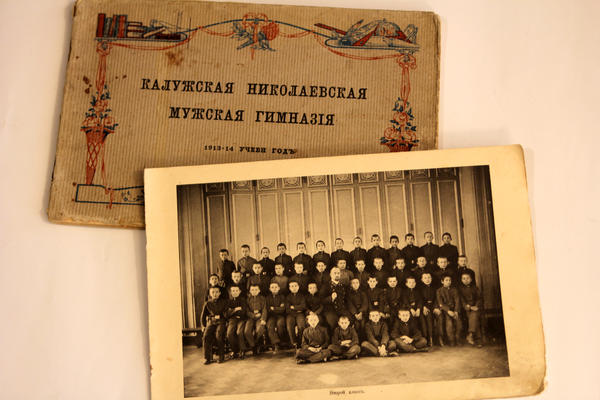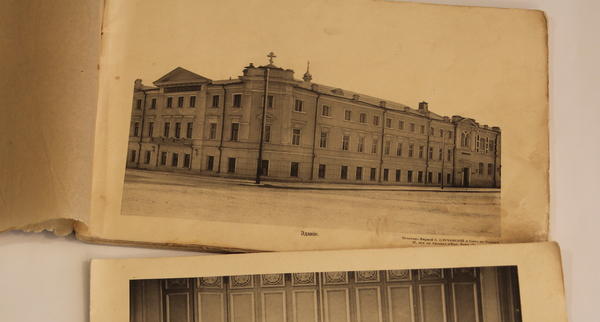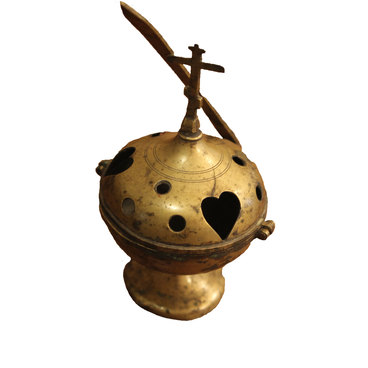In 1914 Paris printing house Sluchansky and Sons printed for Kaluga photographs of high schools so that all students could get an album as a souvenir of school years.
The exhibited album was owned by Boris Kushakov. He was transferred to Kaluga Male Nikolaev Gymnasium from the one in Tambov. Domogatsky brothers helped arrange the transfer. They were merchants and Boris’s family lived in their estate. Kushakov entered the gymnasium in 1909 and completed the full course of study in 6 years. In grade 7 Boris acquired the album containing photographs of his alma mater after major renovation.
The gymnasium building was constructed in late XVIII century according to the design of Petr Nikitin – the author of Kaluga urban area development plan. A public school was opened there in 1786, transformed into a gymnasium in 1804 that operated until 1917.
In various years, famous people served as gymnasium directors, like Semen Unkovsky, a friend and associate of Admiral Mikhail Lazarev and participant of a world tour on “Suvorov” sloop. When Nicholas I visited the school, he asked the sea goer if managing the gymnasium was easier than steering a ship. “Not at all, Your Majesty, ” – replied Unkovsky. – “Here everyone is a vessel, and each is going their way”. Another sea goer director came to the gymnasium in 1834 – Semen Yanovsky, chief manager of the Russian America.
In 1904, Kaluga Male Gymnasium celebrated its 100-th anniversary. A grandiose celebration was planned for December 6 with attendance by Nicholas II and Foreign Minister Vyacheslav von Plehve who graduated from the gymnasium. But the plans had to be changed due to the beginning of the Russian-Japanese war. The celebration still happened but only the Kaluga city governor came to congratulate students and teachers. By His Imperial Majesty’s Edict the gymnasium received the name ‘Nikolaev’.
Two years later the gymnasium underwent a massive restoration and alteration, with 12 new classrooms built as a result. The rooms of the students who lived in the gymnasium, the canteen and quiet rooms for study were located on the second floor.
During World War I the gymnasium housed the regional evacuation hospital. In the 1920’s the building was used for the Revolutionary Satire Theater, then a Soviet party school of the province, and later - 1-st model high school. During the Great Patriotic War the building was again turned into a hospital, and after the end of the war was used for administrative offices. In 1951 the departments of humanities of K.E. Tsiolkovsky Kaluga State Pedagogical Institute moved to the building (presently K.E. Tsiolkovsky Kaluga State University).
The exhibited album was owned by Boris Kushakov. He was transferred to Kaluga Male Nikolaev Gymnasium from the one in Tambov. Domogatsky brothers helped arrange the transfer. They were merchants and Boris’s family lived in their estate. Kushakov entered the gymnasium in 1909 and completed the full course of study in 6 years. In grade 7 Boris acquired the album containing photographs of his alma mater after major renovation.
The gymnasium building was constructed in late XVIII century according to the design of Petr Nikitin – the author of Kaluga urban area development plan. A public school was opened there in 1786, transformed into a gymnasium in 1804 that operated until 1917.
In various years, famous people served as gymnasium directors, like Semen Unkovsky, a friend and associate of Admiral Mikhail Lazarev and participant of a world tour on “Suvorov” sloop. When Nicholas I visited the school, he asked the sea goer if managing the gymnasium was easier than steering a ship. “Not at all, Your Majesty, ” – replied Unkovsky. – “Here everyone is a vessel, and each is going their way”. Another sea goer director came to the gymnasium in 1834 – Semen Yanovsky, chief manager of the Russian America.
In 1904, Kaluga Male Gymnasium celebrated its 100-th anniversary. A grandiose celebration was planned for December 6 with attendance by Nicholas II and Foreign Minister Vyacheslav von Plehve who graduated from the gymnasium. But the plans had to be changed due to the beginning of the Russian-Japanese war. The celebration still happened but only the Kaluga city governor came to congratulate students and teachers. By His Imperial Majesty’s Edict the gymnasium received the name ‘Nikolaev’.
Two years later the gymnasium underwent a massive restoration and alteration, with 12 new classrooms built as a result. The rooms of the students who lived in the gymnasium, the canteen and quiet rooms for study were located on the second floor.
During World War I the gymnasium housed the regional evacuation hospital. In the 1920’s the building was used for the Revolutionary Satire Theater, then a Soviet party school of the province, and later - 1-st model high school. During the Great Patriotic War the building was again turned into a hospital, and after the end of the war was used for administrative offices. In 1951 the departments of humanities of K.E. Tsiolkovsky Kaluga State Pedagogical Institute moved to the building (presently K.E. Tsiolkovsky Kaluga State University).




